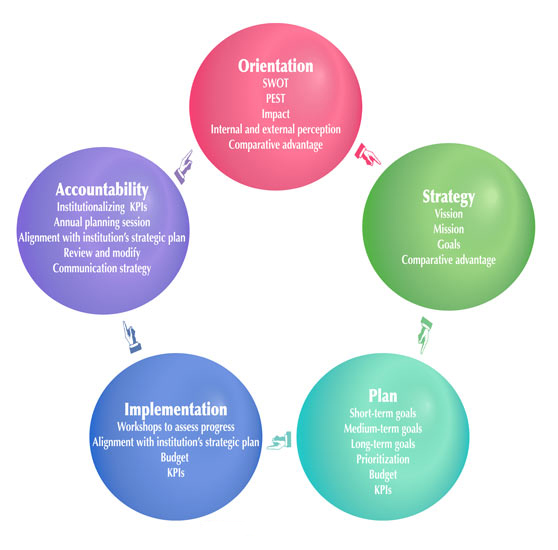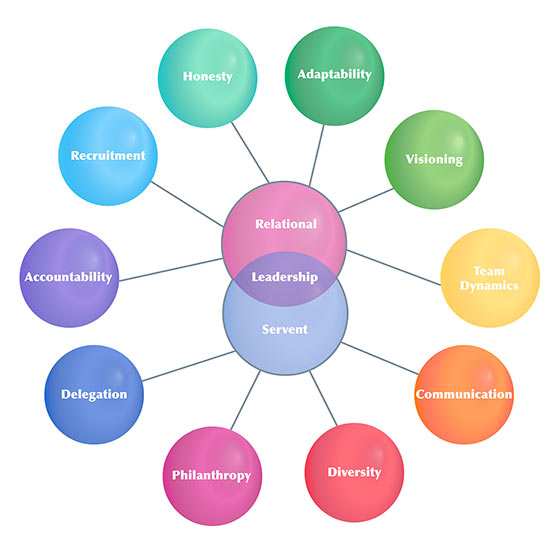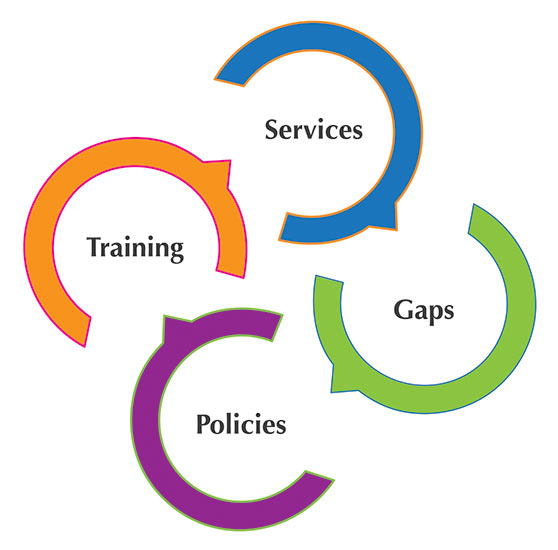

STRATEGIC PLANNING
Strategic Planning is one of the most consequential activities that an institution undertakes, yet most strategic planning processes comprise lots of work and the efforts of many, but little in the way of implementable and successful outcomes.
HNRMC has extensive hands-on experience in strategic planning in higher education, and has developed a highly successful five-phase approach using a design thinking framework to guarantee the success of this process.
Design Thinking is a human-centered design methodology that leads quickly from problem statement to creative solutions. Design Thinking is widely used when creative solutions are sought to meet customer needs and when broad input from a diversity of stakeholders add value to finding a solution. It moves participants through a rapid succession of stages to generate ideas that can then be vetted more broadly, refined, and tested.
Phase 1 (Orientation) begins with an assessment and analysis of the current state of the institution, including a review of the current vision, mission, and goals, using a Strengths, Weaknesses, Opportunities, and Threats (SWOT) analysis. Incorporation of political, economic, sociocultural, and technological (PEST) inputs into the assessment of the current state complements the initial analysis. Next, using information gleaned from the SWOT and PEST analysis, HNRMC fleshes out a set of critical questions to inform the development of the strategic plan. HNRMC concludes the first phase with the development of a survey for internal and external stakeholders.
Phase 2 (Strategy) combines a review of the survey responses, refinement of the SWOT and PEST analysis and the generation of ideas to visualize the desirable future state of the institution, including the development of a vision, mission and goals in the context of the institutions comparative advantages.
Phase 3 (Plan) focuses on the development of specific actions (programmatic ideas, new administrative processes, etc.) to implement the strategic plan accompanied by short-, medium-, and long-term goals, prioritization of the goals and the development of Key Performance Indicators (KPIs) to monitor progress of the plan.
Phase 4 (Implementation) includes workshops to monitor, review, evaluate, and correct KPIs, the strategic plan and the yearly operating plan, assess progress on implementing goals, and review the budget.
Phase 5 (Accountability) includes internal and external communication strategies, continued reviews of KPIs and progress on implementation of the strategic plan, budget considerations and any necessary course corrections.

Leadership Development
Effective leadership is an absolute must for the success of any organization. While roughly 75% of existing organizations invest significant sums in leadership development and universities offer a plethora of courses and degrees in leadership, only about 25% of current leaders think these programs have any value.
Even more striking is that only ~10% of current CEOs/Presidents think that their own organizations create effective leadership development and succession planning.
Effective leaders possess a number of qualities including creating sound strategies for their teams, understanding and devoting significant time to the recruitment of excellent people, leading by example, understanding the importance of being agile to adapt to changing conditions, and being fastidious in honoring their commitments, admitting their mistakes and taking responsibility for their failures.
Higher Education presents special challenges with respect to leadership. The culture of higher education rewards individual accomplishment. Most university leaders rise through this culture and carry with them the culture and its strategies. Universities also consist of large numbers of stakeholders (faculty, students, staff, local communities, businesses and industry, etc.). Inability to agree on a small number of priorities that are aligned with institutional mission, regional needs and the collective shared interests of internal/external stakeholders challenge effective leadership. Higher education leaders are also facing loss of public trust in their missions, increasing fiscal constraints and the views that higher education is elitist and too liberally minded philosophically.
HNRMC has extensive experience in higher education across faculty and senior administrative leadership positions. Critical to our process are the practice of Relational Leadership and Servant Leadership. These principals are combined with coaching in visioning, team dynamics, communication, diversity, fund raising, effective delegation and mutual accountability. HNRMC guides new and established departments, centers/institutes, colleges and entire institutions in creating a collaborative culture that promotes convergent as well as disciplinary research, teaching, student mentorship, and service efforts.

Faculty & Administrator Coaching
Most successful individuals credit a coach or mentor as critical to their success. Coaches and mentors create partnerships that enable the mentee to maximize their own performance. Coaches and mentors willingly share career experiences, provide emotional and moral support, help individuals learn specific skills, provide feedback, serve as a fountain of broad based information, foster important connections and visibility, and help shape careers and encourage successful outcomes.
At each step of an academic's career, individuals confront many questions about the best path forward for success. These can relate to how to be an effective lecturer, promotion and tenure strategies, successful grant writing, engaging in their service missions to the institution, becoming an accepted and respected member of an increasingly culturally diverse professional community, effectiveness as an administrator and appropriate social interaction and communication skills.
At HNRMC, we have decades of coaching/mentoring experience with individuals from undergraduates to University Presidents and Chancellors. We offer a discrete, objective sounding board for ideas, help with strategy development and measurement of progress against the strategy, and suggest changes in behavior and habits that offer positive outcomes. Our capabilities encompass the areas of academic leadership, teaching, research, service, writing and career planning. We listen and ask questions to understand the needs, wants and desires of our clients. We develop a short and long term work plan focused on those areas where the most support and impact is needed, including helping the client recognize his/her own current strengths and weaknesses. Providing supportive but direct feedback, regular reviews of the progress on the work plan (including review of specific documents if appropriate) is performed, and support is provided at regular intervals as long as the client or institution feels there is a need.
Organizational Effectiveness
Operational Efficiency
Academic institutions must identify new ways to remain productive, innovative, efficient and solvent. Universities and colleges are challenged as never before by growing public concern regarding the cost and value of higher education, increasing competition for research funding, and an ever expanding mission that now far exceeds generating and passing on knowledge. Administrative expenditures seem to increase unabated and outpace investment in the core missions, while increasing administrative tasks divert investigator effort away from teaching, research and service missions.
Structurally, academic institutions have operated as a loosely coordinated group of departments, colleges and centers/institutes, each with their own administrative infrastructure and culture. Such structures have often led to (unnecessary) duplication of resources and work flow processes and lead to higher overall administrative costs to the institution. At the same time, new models of educational delivery (online learning) and research (translational, collaborative and interdisciplinary, often involving stakeholders from outside academia) have led to an increased focus on quality, cost and a much-accelerated timescale for tangible results. Academic institutions today need to acutely focus on ways to reduce administrative costs, improve productivity, and reduce redundancy while increasing organizational flexibility and enhancing service to their stakeholders.
HNRMC has the experience and record of accomplishments to work with academic institutions to re-align their institutional strategies with regional and national priorities, develop metrics to measure performance and track progress, and identify innovative approaches to unlock the value of their mission and faculty. We can:

Research Impact and Productivity -
Everyone wants to do things that matter, whether at the individual, institutional, community or societal level. The collective size of the academic research enterprise, its diversity, and intellectual and physical capital position it well for competing as a leader in creating new knowledge that will benefit our society.
Universities are increasingly using their own internal funds to finance research expenses that were once supported by external sources. Schools funded about 12 percent of research on campus in the 1950s. By 2014, almost a quarter of research dollars came not from outside funders but from university coffers. This so-called institutional funding has served as a backfill, making up the difference for higher education when federal funding is flat.
Most measures of change are focused on metrics that are easy to obtain and consistent between organizations but ultimately fail to measure real, practical impact. To be successful, research organizations will need to take a hard look at their business models and the value proposition they provide to their communities. New metrics of impact and importance will need to be developed that meet the needs of our local/national/global communities. New structures for translating research activity into practical economic and societal benefit will need to be generated. HNRMC can:

Competitive, Collaborative, Entrepreneurial Research Partnerships -
Research is transforming from an independent activity to one involving a variety of partners across disciplines, institutions and industries. Increasing the quantity and quality of multi-institutional research collaborations is part of an overall goal to increase research capacity, provide a highly trained knowledge-based workforce, increase technology transfer, and maintain global competitiveness.
A new organizational model for research that rewards collaboration, innovation and entrepreneurship is needed to remain nationally and globally competitive. These new models will create an imperative for change but will also challenge current organizational structures.
What is needed are institutional support and incentives for collaborative research, appropriate research infrastructure, an environment that favors technology transfer, a culture that supports entrepreneurship, training in effective research collaboration, and incentives for scientists to participate in multi-institutional research. Our team has extensive experience in leading just these kinds of organizational changes. HNRMC works to optimize the value of existing research operations, guides the development of collaborations within and across institutions, promotes the creation of public-private partnership, and fosters productive community engagement. HNRMC can help institutions with:

RESEARCH INFRASTRUCTURE -
Today's researchers rely on specialized instrumentation and highly skilled technicians to generate high-quality data. Much of the instrumentation no longer resides in a researcher's lab but in core research facilities that are centralized and operated by research staff and technicians. Researchers often interact with multiple core facilities on a single research project.
Outsourcing data acquisition to core facilities poses challenges to both researchers and administrators. The lack of coordination among core facilities with different workflows and administrative processes together with the much increased complexity and size of the data generated in the facility challenges the research community. Institutional culture often resists the move toward shared instrumentation, which adds to the cost of research and results in duplication. Administration moreover is challenged with the need to balance the cost of managing core facilities with the steady demand of the research community to provide up-to-date instrumentation to stay competitive for funding.
Nowadays, most life and health science investigators use big data sets in their research, with DNA/RNA/protein sequences being the most common type. With the rapid change in analysis methods and the episodic nature of analysis needs, labs face the additional challenge of having to be familiar with whatever is the most appropriate analysis method when they are ready to analyze their data. Very likely, the most appropriate method is different from the one they had used previously.
HNRMC has extensive experience working with core research facilities and researchers to develop standardized workflows and to bridge the gap between high-throughput data acquisition and data analysis. HNRMC can help your institution to:


DATA ANALYTICS -
Organizations are awash in data. Tools are increasingly becoming available to transform raw data into actionable information with the promise of increasing the quality and the efficiency of decisions.
This raises issues of both how the information is used in decision making and how the decision making is monitored to assess proper outcomes. There is little guidance or training on how to appropriately incorporate the output of these algorithms into the decision making process.
The promise of increased objectivity and efficiency is pushing the use of these tools. The decrease in autonomy of individual employees is a particularly thorny issue in professions where highly trained professionals are used to making decisions based on their own professional judgment.
For instance, academic advisers routinely assess the risk of a student failing based on their professional experience and judgment. Algorithms are now available that can predict the risk of failing based on large data sets of students with similar profiles. When the algorithmic recommendation is at odds with professional judgment, an unavoidable conflict arises. Not following the recommendation when the recommendation turns out to be correct is likely more detrimental to an employee than following the algorithmic recommendation when it turns out to be incorrect, leading to an overreliance on algorithms.
Professionals need to receive training to better understand the shortcomings of algorithmic decision making, and organizations need to empower professionals to continue to use their professional judgment. Organizations also need to build trust and set transparent rules on how employee data will be used in performance evaluations.
HNRMC has experience in working with professionals on how to use algorithmic output in decision making and advising organizations on how to use data in employee performance evaluation.

Data Management -
Universities struggle with meeting their faculty's requests for management of research data across the data life cycle. This is a multifaceted issue and requires expertise in areas of policy development, data governance, data access, data sharing, workflows for data analysis, and data storage, with the goal of creating high quality, reusable data and documentation for the public and scientific community. Increasingly, the development of policies and practices involves multiple public and private entities and requires protection of proprietary data in ways that allow its use without compromising confidentiality of the data. Data storage requests are increasing in size, have complex security demands, and vary in availability requirements. On top of these demands, there is a need for archival storage to keep the data for potential future purposes or to meet regulatory requirements. Faculty struggle with selecting appropriate data storage solutions among the different options and understanding the responsibilities imposed by university policies and funding agency requirements.
IT departments can readily respond with technology solutions but are often at a loss understanding the nuances of data storage requirements and the academic culture of managing data. Administrators are under pressure to reduce cost and duplication of services. Faculty want clear and easy to use data storage solutions and do not have the patience to search through websites of different storage providers within their institution.
Adoption of recommendations requires the buy-in of faculty, administrators, and data storage providers. Technology is only part of the solution. More pressing is a cultural shift toward close collaboration and mutual understanding of the three communities of stakeholders.
HNRMC will guide your organization through a 4-step process to aid your campus in this cultural shift and to make your digital storage solutions transparent to the academic community and its relevant stakeholders, identify gaps, consolidate and develop policies, and structure the training.
RESEARCH ETHICS, INTEGRITY AND COMPLIANCE PROGRAMS -
In recent years, university missions have come under intense public scrutiny. Institutions of higher education, which rely on public funding, must yield measurable benefit, demonstrate rigor, and uphold high standards of integrity in order to maintain the public trust. But efforts to provide such accountability increasingly leave faculty and in particular research institutions collapsing under the weight of administrative requirements and regulatory constraints. The oft-quoted figure that scientists spend nearly 42% of their effort on paperwork and administrative tasks describes a system in peril.
Without question, the responsible conduct of research, reproducibility, human participant protection and animal welfare all require diligence and come at a significant cost in time and expense. However, many regulations impacting research are widely viewed as unnecessarily complicated, often burdensome and of uncertain merit. Unfortunately, what has evolved in many academic domains is a culture driven by avoidance of risk above all other priorities.
With the potential for other significant regulatory changes ahead, research universities must be prepared to embrace opportunities to enhance productivity while intelligently applying new rules. The key will be in restoring balance at the institutional level, developing a culturally appropriate risk tolerance so that effort is refocused on discovery, productivity and integrity, and on streamlined administrative compliance to support these goals.
HNRMC understands these challenges and has extensive experience leading organizations in the development of effective research integrity and compliance programs. HNRMC offers unique experience in the development and implementation of human research policies and strategies to promote participant involvement, engagement and protection. Within a constantly changing regulatory climate, our firm works to support the alignment of institutional scientific priorities, ethical standards and reputational concerns with compliance mandates. We can help your institution to:

How Can We Help?
Herman, Neuhauser Research Management Consulting, Inc., offers comprehensive analytic,
advisory and implementation services for research organizations.